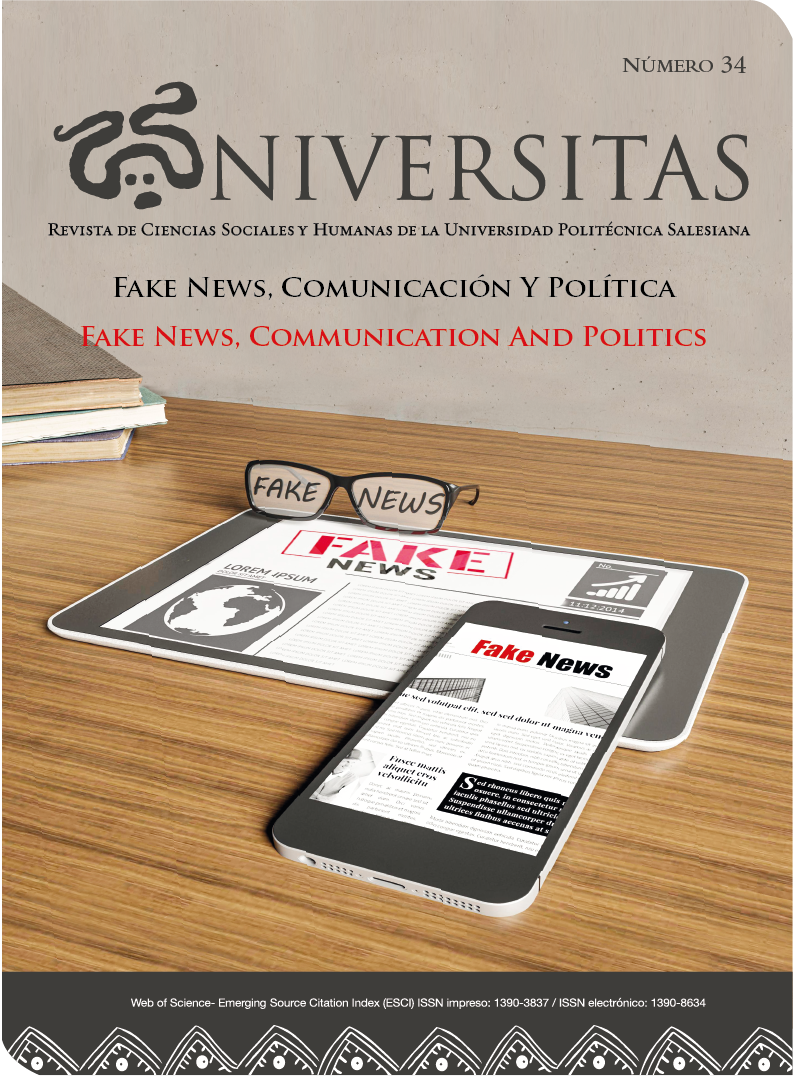Noticias falsas y creencias infundadas en la era de la posverdad
Contenido principal del artículo
Resumen
Detalles del artículo
La Revista Universitas-XX1 se alinea con los principios de acceso abierto y colaboración académica al adoptar la licencia Creative Commons Atribución-NoComercial-CompartirIgual 4.0 Internacional (CC BY-NC-SA 4.0). Esta licencia garantiza que los contenidos publicados puedan ser utilizados y compartidos ampliamente bajo las siguientes condiciones:
Atribución: Los autores y la revista deben ser reconocidos adecuadamente como los creadores del contenido original, proporcionando la referencia completa y el enlace correspondiente a la publicación.
Uso no comercial: Los contenidos no pueden ser utilizados con fines comerciales, preservando su propósito académico y educativo. Compartir igual: Las obras derivadas deben distribuirse bajo los mismos términos de esta licencia, fomentando la creación de conocimiento accesible y equitativo.
Al implementar esta licencia, la Revista Universitas-XXI refuerza su compromiso con la difusión de investigaciones de calidad, el acceso libre al conocimiento y la promoción de un entorno colaborativo entre investigadores, docentes y estudiantes de todo el mundo.
Esta decisión refleja los valores fundamentales de responsabilidad, ética y transparencia en el ámbito académico, asegurando que los aportes intelectuales sirvan como base para nuevas investigaciones y proyectos, respetando los derechos de los autores y de la comunidad científica.
Para más información sobre esta licencia, puede consultar el siguiente enlace: https://creativecommons.org/licenses/by-nc-sa/4.0/
Referencias
Beck, A., & Clark, D. (1997). An information processing model of anxiety: Automatic and strategic processes. Behaviour Research and Therapy, 35(1), 49-58. https://doi.org/10.1016/S0005-7967(96)00069-1
Brashier, N., & Multhaup, K. (2017). Magical thinking decreases across adulthood. Psychology and aging, 32(8), 681-688. https://doi.org/10.1037/pag0000208
Bronstein, M., Pennycook, G., Bear, A., Rand, D., & Cannon, T. (2019). Belief in fake news is associated with delusionality, dogmatism, religious fundamentalism, and reduced analytic thinking. Journal of Applied Research
in Memory and Cognition, 8(1), 108-117. https://doi.org/10.1016/j.jarmac.2018.09.005
Caldera, J., Reynoso, O., Zamora, M. d., & Pérez, I. (2017). Pensamiento mágico en estudiantes. Estudio comparado entre niveles educativos. Revista Iberoamericana para la Investigación y el Desarrollo Educativo, 8(15), 505-528. https://doi.org/10.23913/ride.v8i15.308
Dagnall, N., Denovan, A., Drinkwater, K., Parker, A., & Clough, P. (2016). Toward a better understanding of the relationship between belief in the paranormal and statistical bias: the potential role of schizotypy. Front. Psychol., 7, 1045. https://doi.org/10.3389/fpsyg.2016.01045
David, D., Lynn, S., & Ellis, A. (2010). Rational and irrational beliefs: Research, theory, and clinical practice. Oxford University Press.
Epstein, S. (1998). Constructive Thinking: The key to emotional intelligence. Prager.
Epstein, S. (2012). Manual inventario de pensamiento constructivo. Una medida de la intelgencia emocional. TEA Ediciones.
Flichtentrei, D. (2018). Posverdad: la ciencia y sus demonios. Revista del Hospital Interzonal General de Agudos (HIGA) Eva Perón, 6(1), 114-118. https:// bit.ly/3jNTZoz
Garrett, N., Lazzaro, S., Ariely, D., & Sharot, T. (2016). The brain adapts to dishonesty. Nature, 19(12), 1727-1732. https://doi.org/10.1038/nn.4426
Gronemeyer, M., & Porath, W. (2017). Tendencias de la posición editorial en diarios de referencia en Chile. El arte de dosificar la crítica frente a la actuación de los actores políticos. Revista de Ciencia Política, 37(1), 177-202.
http://dx.doi.org/10.4067/S0718-090X2017000100008
Habermas, J. (1991). The structural transformation of the public sphere: An inquiry into a category of bourgeois society. The MIT Press.
Halpern, D., Valenzuela, S., Katz, J., & Miranda, J.-P. (2019). From belief in conspiracy theories to trust in others: which factors influence exposure, believing and sharing fake news. En G. Meiselwitz, Social computing and
social media. Design, human behavior and analytics (pp. 217-232). Springer. http://doi.org/10.1007/978-3-030-21902-4_16
BIBLIOGRAPHY Latinobarómetro (2018). Informe 2018. Santiago de Chile.
Lazer, D., Baum, M., Benkler, Y., Berinski, A., Greenhill, K., Menczer, F., Metzger, M., Nyhan, B., Pennycook, G., Rothschild, D., Schudson, M., Sloman, S., Sunstein, C., Thorson, E., Watts, D., & Zittrain, J. (2018). The science
of fake news. Science, 359(6380), 1094-1096. http://doi.org/10.1126/
science.aao2998
Leonard, C., & Williams, R. (2019). Fallacious beliefs: Gambling specific and belief in the paranormal. Canadian Journal of Behavioural Science, 51(1), 1-11. http://dx.doi.org/10.1037/cbs0000113
Metzger, M., Flanagin, A., & Medders, R. (2010). Social and heuristics approaches to credibility evaluation online. Journal of Communication, 60(3), 413- 439. https://doi.org/10.1111/j.1460-2466.2010.01488.x
Moya, M. (1999). Persuación y cambio de actitudes. En F. Morales, & C. Huici, Psiclogía Social (pp. 153-170). McGraw-Hill.
Nigro, P. (2018). Causas de la pérdida de confianza en la prensa y estrategias para su restablecimiento en un contexto de incertidumbre. Hipertext.net (17), 54-63. https://dx.doi.org/10.31009/hipertext.net.2018.i17.05
Pennycook, G., & Rand, D. (2019). Who falls for fake news? The roles of bullshit receptivity, overclaiming, familiarity, and analytic thinking. Journal of Personality, 1-16. https://doi.org/10.1111/jopy.12476
Pennycook, G., McPhetres, J., Zhang, Y., Lu, J., & Rand, D. (2020). Fighting COVID-19 misinformation on social media: Experimental evidence for a scalable accuracy nudge intervention. Psychological Science, 31(7),
770-780. https://doi.org/10.1177/0956797620939054
Rampersad, G., & Althiyabi, T. (2019). Fake news: Acceptance by demographics and culture on social media. Journal of Information Technology & Politics, 1-11. https://doi.org/10.1080/19331681.2019.1686676
Rodríguez, C., & Valenzuela, M. (2019). Entre milagros, espíritus y esoterismo: pensamiento mágico y pseudociencia en el Chile globalizado del siglo XXI. Universitas Psychologica, 18(4), 1-13. https://doi.org/10.11144/Javeriana.upsy18-4.emee
Rogers, P., Fisk, J., & Lowrieb, E. (2018). Paranormal belief, thinking style preference and susceptibility to confirmatory conjunction errors. Consciousness and Cognition, 65, 182-196. https://doi.org/10.1016/j.concog.2018.07.013
Sagan, C. (2000). El mundo y sus demonios. Planeta.
Sobrado, A., González-García, C., & Ruz, M. (2018). ¿Por qué unas tareas mentales
nos cuestan más que otras? El esfuerzo cognitivo y la percepción subjetiva de la dificultad. Ciencia Cognitiva, 12(2), 42-44.
Stuart-Hamilton, I., Nayak, L., & Priest, L. (2006). Intelligence, belief in the paranormal, knowledge of probability and aging. Educational Gerontology, 32(3), 173-184. https://doi.org/10.1080/03601270500476847
Sülflow, M., Schäfer, S., & Winter, S. (2019). Selective attention in the news feed: An eye-tracking study on the perception and selection of political news posts on Facebook. new media & society, 21(1), 168-190. https://doi. org/10.1177/1461444818791520

